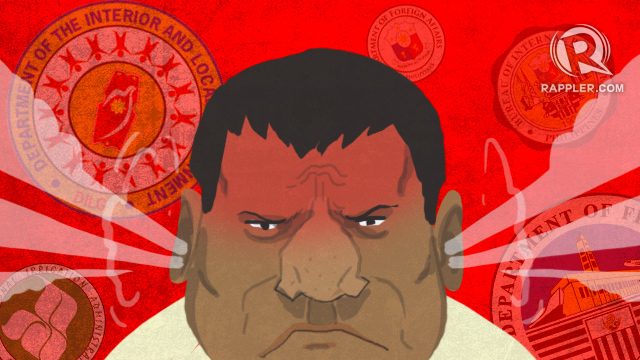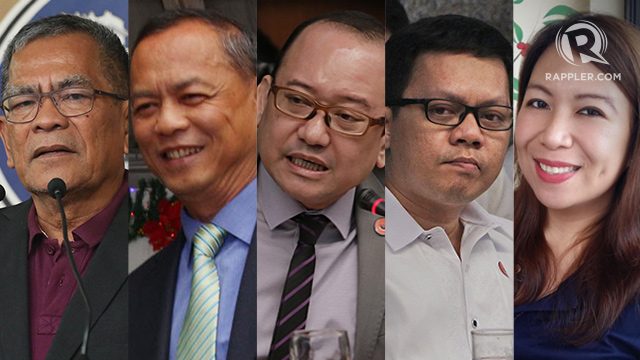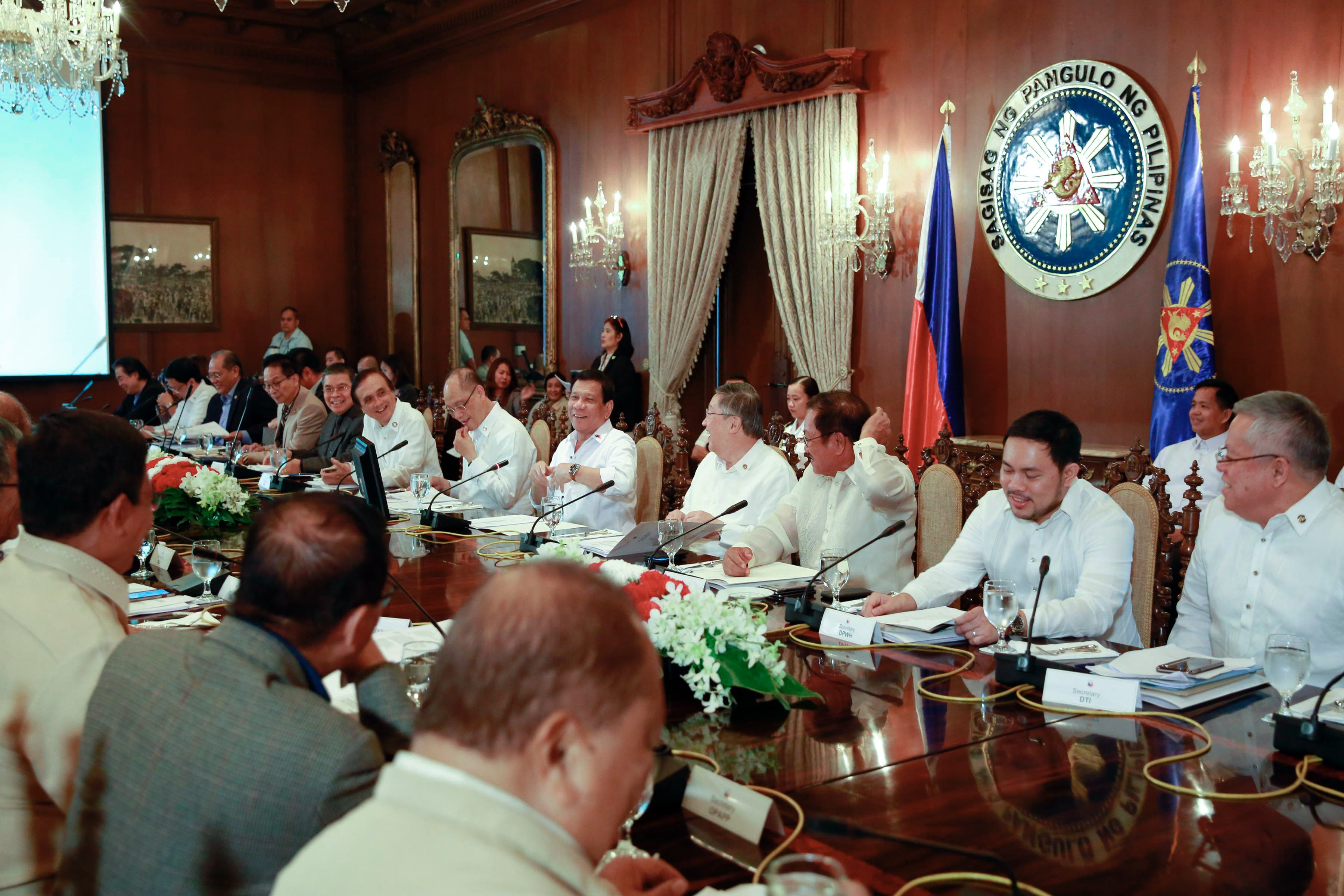SUMMARY
This is AI generated summarization, which may have errors. For context, always refer to the full article.

MANILA, Philippines – Not even a year into his presidency, President Rodrigo Duterte already seems to be on a firing spree.
Last Monday, April 3, he sacked Interior Secretary Ismael Sueno, during a full Cabinet meeting no less. Two days after, he fired a Palace undersecretary as his chopper was landing in Nueva Ecija. Two more undersecretaries are on their way out, he warned.
So far, he has fired 5 ranking officials, all his appointees.
Most recently, he sacked Office of the Cabinet Secretary Undersecretary Halmen Valdez for supposedly trying to overturn the denial of rice importation permits being sought by National Food Authority chief Jason Aquino.
A month before axing Sueno, he fired his campaign spokesman and sometime right-hand man Peter Laviña from his post as National Irrigation Administration chief.
Last December, he announced he had sacked two fraternity brothers of his who were at the time Bureau of Immigration Deputy Commissioners – Michael Robles and Al Argosino.
How Duterte parts ways with his appointees speaks volumes of his leadership and governance style.
What we’ve seen so far is brash decision-making and a penchant for public condemnation. What impact does his “one whiff, you’re out” rule have on his Cabinet and the public? What does it say about his supposed hardline stance against corruption?
Duterte’s firing style
A pattern emerges from the manner by which Duterte has fired officials so far. The officials he has fired share some things in common.

1. Close ties with Duterte
Four out of 5 of these officials used to enjoy close ties, even warm friendship, with him. Sueno was part of his inner circle who convinced him to run for President. As chairman of Duterte’s political party, PDP-Laban, he campaigned hard for him during the elections. Duterte used to speak fondly of Sueno as one of the former seminarians in his Cabinet.
Laviña was once Duterte’s aide, starting way back 1988 when he first ran for mayor. He eventually ran for Davao City councilor. In the 2016 campaign, Laviña resurfaced as his campaign spokesman.
Meanwhile, the BI Deputy Commissioners Al Argosino and Michael Robles are fraternity brothers of Duterte.
Valdez was also an appointee under the administration of Benigno Aquino III where she worked under the Office of the Presidential Assistant on Food Security and Agricultural Modernization. But Duterte reappointed her, this time as an undersecretary under the office of one of his most trusted men, Cabinet Secretary Leoncio Evasco Jr.
2. Accused of wrongdoing by officials in the same department
In 4 of the 5 cases, Duterte got wind of their supposed involvement in corruption or suspicious activities from another official in the same department. In Sueno’s case, 3 undersecretaries who belonged to a Duterte campaign group told on him.
In Laviña’s case, NIA personnel from Mindanao alleged he wanted kickbacks from irrigation projects.
For Argosino and Robles, no less than fellow Bedan Justice Secretary Vitaliano Aguirre recommended to Duterte that they be sacked.
3. Inconsistent investigation process
If Duterte indeed did “due diligence” and investigated the claims against these officials, as the Palace claims, he has not explained this to the public. In fact, from what the media has been able to gather, Duterte seems to have decided to fire some of these officials right after hearing about the allegations.
In the case of Laviña, for example, he admitted firing him the same night he met with NIA directors in Davao City and was told about Laviña’s supposed overtures to them for kickbacks. Valdez, he fired after merely having a conversation about her with fellow chopper passengers.
As for Sueno, the Palace said Duterte “checked into” Sueno’s “history of activities.” Aguirre said the President also relied on “Malacañang lawyers” to conduct an investigation. From Duterte’s version of things, he had asked the lawyers to check the legal soundness of Sueno’s actions.
However, in the case of Argosino and Robles, an investigation was conducted by the Department of Justice. They were accused of accepting bribe money from gambling tycoon Jack Lam and offering part of the money to Aguirre. It was Aguirre who recommended their termination.
4. Public shaming without naming
To the frustration of journalists, Duterte has never named in his public speeches officials whom he fired. This has made it difficult to verify his allegations and report on the official’s dismissal. Could it be his last gesture of friendship?
But though he does not name them, he always mentions their dismissal, and describes, quite vividly, how he fired them. Clearly, he is using their dismissal as sound bites to buffer his claim of a tough stance against corruption.
5. No follow-up action
So far, Duterte has not done more to hold the officials he has fired accountable for corruption. While it is not his job to prosecute individuals, his office seems to not have endorsed the cases to the Office of the Ombudsman for prosecution. When asked if cases would be filed against Sueno and Laviña, Presidential Spokesman Ernesto Abella merely asked the public to “wait for the President to make his subsequent actions.”
‘Governance by instinct’
Duterte’s manner of firing officials is part of his “highly personalized style of leadership,” said Aries Arugay, an Associate Professor of Political Science from the University of the Philippines-Diliman.
The President has a penchant for big gestures to prove his point, in this case, his “zero tolerance” for corruption.
“The firing of high profile Cabinet officials further proves his performative style,” added Arugay.
Former dean of the Ateneo School of Government Tony La Viña (disclosure: La Viña is a distant relative of Peter Laviña), meanwhile, said it’s typical of Duterte, who prizes decisive action over tedious but necessary process.
“It’s governance by instinct and passion, of selective political will, and no due process or rule of law,” La Viña told Rappler.

Experts agree, though, that Duterte’s spectacular dismissals of officials are likely to please the public.
Ateneo de Manila Assistant Professor for the Development Studies Program Leloy Claudio called it a “PR (public relations) coup.”
“Although academics and pundits like myself complain about Duterte’s strong arm tactics, the public – especially those in classes AB and C – have constantly affirmed their admiration for what they view as Duterte’s ‘decisive’ leadership,” said Claudio.
His “unconventional” practice departs from former President Aquino’s who had been criticized for not acting on corruption scandals hounding his Cabinet members.
“It’s a complete opposite of Aquino and other presidents who stuck with their Cabinet through thick and thin,” observed Arugay.
But one impact these dismissals might have on the public and Philippine democracy in general is the “short-circuiting” of due process, said Claudio.
It only adds to the administration’s perceived disdain for legal processes in favor of grand gestures that ring the message of “true change” loud and clear.
Impact on the Cabinet
One can only imagine what other Cabinet officials might have felt or thought as they watched Sueno being grilled by Duterte during their April 3 meeting. No one wants to be humiliated in a room full of equals. No one wants to be put on the spot.
Sueno supposedly rushed out of the State Dining Room when Duterte rejected his plea for a private meeting. Who can blame him?
Duterte’s abrupt dismissal of officials no doubt has a “disruptive” effect on the Cabinet, that closed circle of officials who decide on the most important issues and have a direct line to the President.
The positive impact is that Cabinet members will take extra care in ensuring all their actions are above board, “that there should not even be an appearance of conflict of interest,” said La Viña.
But there’s a negative effect too.
“The negative aspect is that government officials can be easily subjected to harassment by their subordinates or stakeholders whose interests might be affected by their decisions,” said La Viña.
In the case of Sueno, he spoke of possible motives of the 3 undersecretaries for speaking ill of him to the President. Sueno claimed the 3 wanted him replaced with TESDA chief Gene Mamondiong, who was chairman of the Mayor Rodrigo Roa Dutere National Executing Coordinating Committee, the campaign group the 3 undersecretaries are members of. Undersecretary John Castriciones, in an interview with dzMM, admitted he bore a grudge against Sueno for limiting his powers.
Does Duterte take the time to investigate motives of those making accusations? Does he take pains to complete the picture before taking drastic action?
Apparently, Duterte is supremely confident that he can never be duped, that his judgement is infallible.
“I can never be misinformed. I’m a lawyer,” he said on Thursday, April 6, during a Palawan event.
Is he convinced by all kinds of allegations or does his level of trust in the information depend on who whispers it to him? If so, his personal judgment of who is credible and who is not becomes the crux.
His style of decision-making doesn’t seem to make room for someone to check on errors he might make.
It doesn’t help that he is inconsistent. Other officials have been entangled in allegations of corruption or incompetence. Take for instance Tourism Secretary Wanda Teo who supposedly asked for two pairs of designer shoes and 150 tickets for a musical from a big shopping mall.
Her fellow tourism official, Tourism Promotions Board COO Cesar Montano, has been accused of hiring friends and relatives, using public funds for personal travels, and incompetence.
Why do these two remain in their positions when others embroiled in similar controversies have been fired?
Demons let loose
If one is lucky enough to have the President’s trust, what’s stopping that person from conjuring up an allegation against a rival official? What’s stopping him or her from abusing that trust?
Duterte doesn’t even seem to put a premium on ensuring safeguards against lies. As he often says in public speeches, the allegations don’t even have to be true for him to fire someone.
“The first whiff – and even if it isn’t true – we’ll say goodbye,” he said on Thursday.
This creates a very wide net for abusers in which to throw in half-truths or outright falsehoods.
Another damaging side effect is possible paranoia among Cabinet officials, a paranoia that could cause rifts in their agencies and even affect their performance.
“It might cause factionalism and in-fighting since character assassination can amount to expulsion from the Cabinet and possibly reputational costs,” said Arugay.
“It might also distract Cabinet members from performing their duties since they have to worry about possible adversaries or saboteurs who undermine their integrity,” he added.
If this manner of firing continues, people might think twice about working for his administration.
“The reputational risks of serving Duterte’s government are going to be high and it might further dissuade people from rendering public service,” said Arugay.
Alternatives
While his apparent zero tolerance for corruption among his subordinates is laudable, “basic fairness” should be observed too, said La Viña.
There are other ways Duterte can weed out dishonest officials in a manner that sends a strong message but still ensures a fair process.
For instance, Duterte can create institutions or agencies like the Presidential Anti-Graft Commission during the administration of Gloria Macapagal Arroyo.
“This institutionalized approach can also render fair judgment if led by reputable individuals and can be transparent in their process of investigation, prosecution, and sanction,” said Arugay.
Duterte could also find a way to work more closely with the Office of the Ombudsman once he hears reports about officials. After all, it is the Ombudsman’s job to investigate and prosecute government officials for such crimes.
This would also address one criticism that Duterte seems to stop at firing officials, with little or no follow-up to ensure they are placed behind bars if they are guilty. The lack of follow-up makes it appear like the officials were given the easy way out.
La Viña also suggests Duterte likewise target abusive lawmakers and politicians, to prove his claim that he owes them nothing.
“I would really like consistency and that he goes after politicians, especially legislators who are corrupt. President Aquino did that but spared many of his allies in the Liberal Party. Duterte does not owe any politician anything so he can go after them,” he said.
Will Duterte always be satisfied to go with his instincts and murmurings of those around him? To be sure, the President has the right to fire Cabinet officials since they serve at his pleasure.
But drastic actions backed up by shaky facts might unleash a flood of consequences even Duterte’s instincts may not be able to control. – Rappler.com
Add a comment
How does this make you feel?
There are no comments yet. Add your comment to start the conversation.